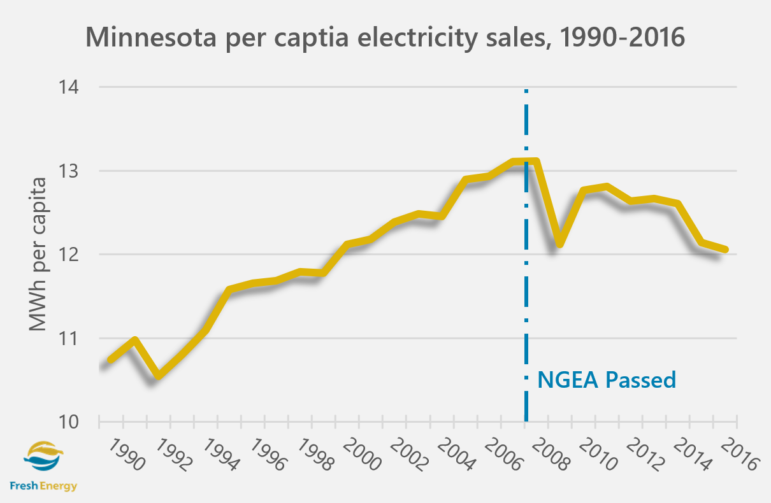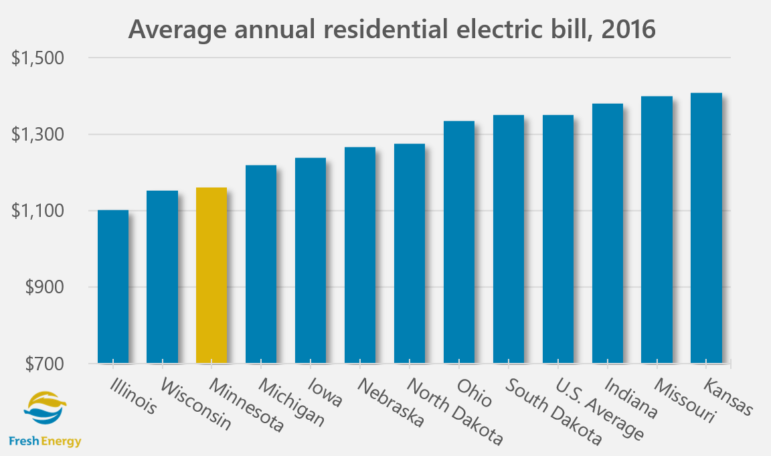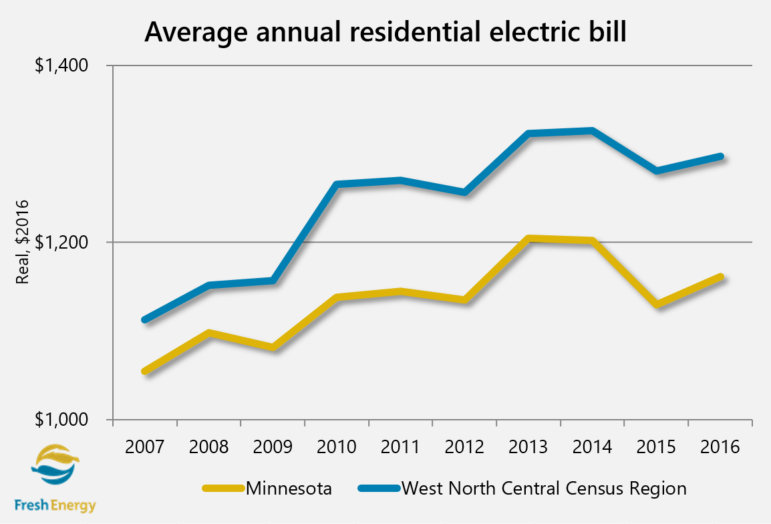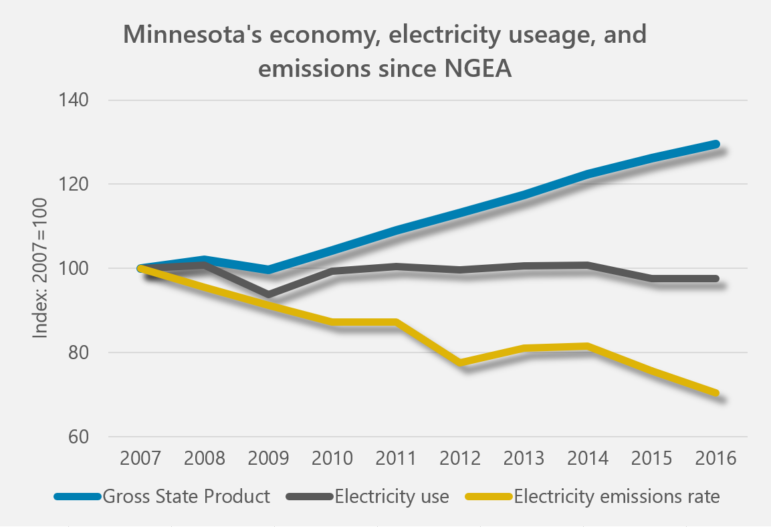
In our current political climate, it’s easy to forget that clean energy used to be widely bipartisan. Passed in 2007 with near universal legislative support and signed into law by Republican Governor Tim Pawlenty, the Next Generation Energy Act was a landmark piece of legislation that aimed to spur renewable energy and save utility customers money through energy efficiency and conservation—all with the goal of reducing greenhouse gas emissions in Minnesota 80 percent by 2050. Ten years later, the Next Generation Energy Act has been a roaring success, cleaning our air, saving us money, and boosting our economy. Here are five ways Minnesota is better off thanks to the Next Generation Energy Act.
1) The Renewable Energy Standard has dramatically lowered greenhouse gas emissions
Thanks to wind and solar power additions, Minnesota’s electricity has become much cleaner since the passage of the Next Generation Energy Act. Greenhouse gas emissions from electricity generation have fallen steadily across the U.S. since 2007, but in Minnesota, emissions rates have fallen even faster, dropping 29 percent from 2007 to 2016. This advantage will likely increase moving forward, thanks to bold leadership from utilities like Xcel Energy, which will get 33 percent of its electricity from wind power by 2021 and aims to get 60 percent of its electricity from renewables by 2030.
More importantly, the carbon dioxide (CO2) emissions reductions in Minnesota will likely prove to be more durable than those of the U.S. The national CO2 reductions are largely due to coal generation being replaced by natural gas, thanks to relatively low natural gas prices. But, historically, natural gas prices have been extremely volatile, and a price increase could mean more coal generation. Relying heavily on natural gas also exposes customers to sudden spikes in fuel costs. By contrast, renewable electricity has no fuel cost, meaning utilities (and customers) know exactly how much they will be paying for renewable generation.

2) The Conservation Improvement Program has reduced electricity consumption
The Next Generation Energy Act not only increased renewable generation, it also spurred energy efficiency. Energy efficiency helps customers use less energy, and save money, even as more appliances and electronics enter our homes and businesses. Per capita electricity sales in Minnesota increased 1.2 percent per year on average between 1990 and 2007. Since the Next Generation Energy Act, however, electricity sales have actually declined by 1 percent per year. This is great news for consumers—who pay lower electric bills—and also for the planet, as all of those emissions are avoided.

3) Minnesota’s electricity bills are among the lowest in the Midwest
Thanks to energy savings and low-cost renewables, Minnesota has some of the lowest electricity bills in the Midwest. Minnesotan families spend $190 less per year on electricity than the national average, or about 15 percent less!

Minnesota’s electric bills have become even more competitive since the Next Generation Energy Act was passed. The chart below shows how residential electricity bills have changed since 2007, comparing Minnesota to our neighbors in the West North Central Census region. Minnesota had slightly lower bills at the time of the Next Generation Energy Act, and since then, bills have grown considerably faster in neighboring states than in Minnesota. Over those 10 years, the average Minnesota family paid $1,100 less for electricity than families in neighboring states.

4) Wind power is the lowest-cost electricity generation source in Minnesota
The Renewable Energy Standard has also helped slash the cost of wind generation, to the point where wind power is, by far, the lowest-cost electricity generation source in Minnesota. The Great Plains have some of the best wind resources in the world, which translates into cheap electricity. How cheap? Utilities in middle America have been purchasing long-term contracts for new wind farms for less than 2¢ per kilowatt hour. By comparison, it costs between 2.5-7.5¢ per kilowatt hour to run an existing coal or natural gas power plant. In other words, it’s cheaper to build a brand-new wind farm—with a guaranteed electricity price over the life of the contract—than it is to simply run a coal or natural gas plant that is already built, even at today’s low natural gas prices.
5) The Next Generation Energy Act has helped Minnesota’s economy
The Next Generation Energy Act has also been a boon to Minnesota’s economy. Investments in renewable generation create about three times more jobs per dollar than fossil fuels. The clean energy sector employs over 50,000 people in Minnesota, and solar installers and wind turbine technicians are the two fastest-growing occupations in the country. Wind farms also pay over $10 million a year to Minnesota counties for roads and schools.
Between 2007 and 2016, Minnesota’s economy grew by 29 percent while greenhouse gas emissions from the electric sector fell by 29 percent—all while Minnesota enjoyed one of the lowest unemployment rates and one of the highest median household incomes in the country.

Given all of these benefits, it’s no surprise that public opinion polls show expanding renewable energy generation is extremely popular with Americans, Democrats and Republicans alike.
This piece was originally published in MinnPost.




